ABS PONTIAC BONNEVILLE 1996 Owners Manual
[x] Cancel search | Manufacturer: PONTIAC, Model Year: 1996, Model line: BONNEVILLE, Model: PONTIAC BONNEVILLE 1996Pages: 387, PDF Size: 18.71 MB
Page 104 of 387
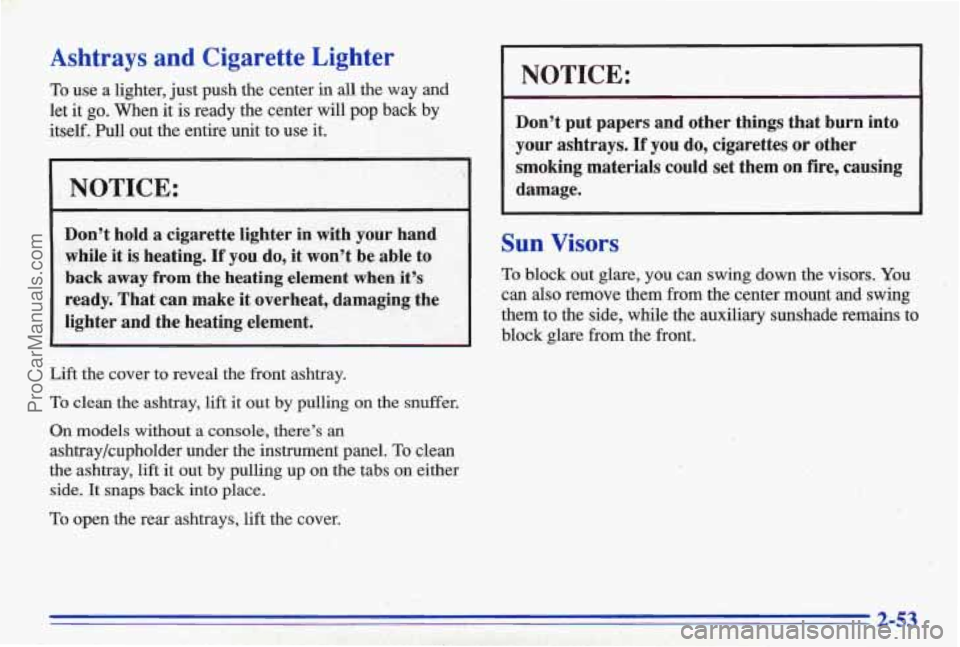
Ashtrays and Cigarette Lighter
To us6 a lighter, just push the center in all the way and
let it go. When it
‘is ready the center will pop back by
itself.
Pull out the entire unit to use it.
NOTICE:
Don’t hold a cigarette lighter in with your hand
while
it is heating. If you do, it won’t be able to
back away from the heating element when it’s
ready. That can make it overheat, damaging the
lighter and the heating element.
Lift the cover to reveal the front ashtray.
To clean the ashtray, lift it out by pulling on the snuffer.
On models without a console, there’s
an
ashtray/cupholder under the instrument panel. To clean
the ashtray,
lift it out by pulling up on the tabs on either
side. It snaps back into place.
To open the rear ashtrays, lift the cover.
NOTICE:
Don’t put papers and other things that burn into
.your ashtrays.
If you do, cigarettes or other
smoking materials could set them
on fire, causing
damage.
Sun Visors
To block out glare, you can swing down the visors. You
can also remove them from the center mount and swing
them to the side, while the auxiliary sunshade remains to
block glare from the front.
2-53
ProCarManuals.com
Page 173 of 387
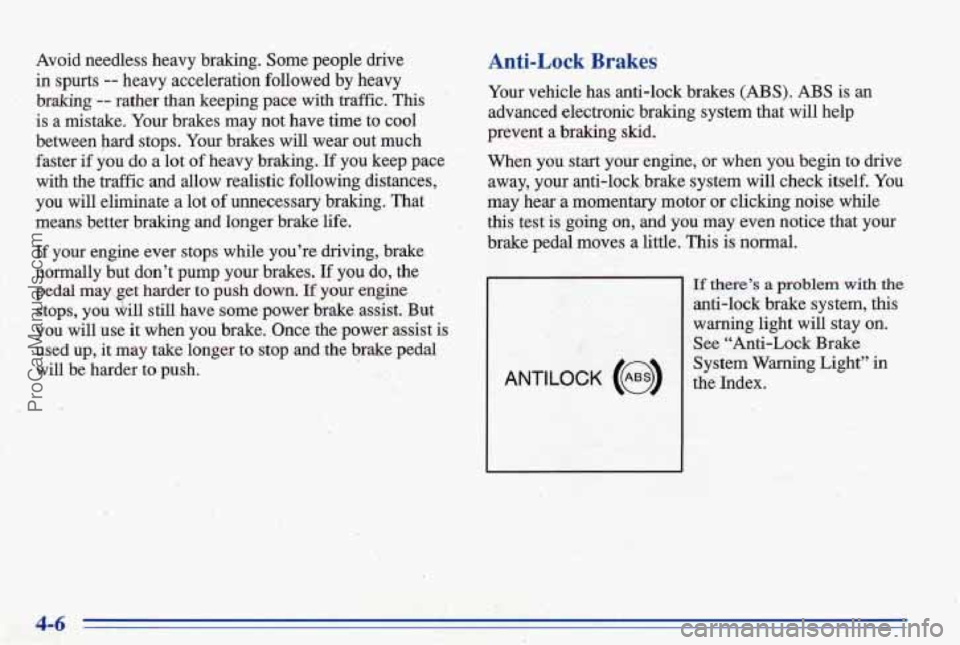
Avoid needless heavy braking. Some people drive
in spurts -- heavy acceleration followed by heavy
braking
-- rather than keeping pace with traffic. This
is a mistake. Your brakes may not have time to cool
between
hard stops. Your brakes will wear out much
faster if you
do a lot of heavy braking. If you keep pace
with the traffic and allow realistic following distances,
you will eliminate
a lot of unnecessary braking. That
means better braking
and longer brake life.
If your engine ever stops while you’re driving, brake
normally but don’t pump your brakes. If you do, the
pedal may
get harder to push down. If your engine -
stops, you dill still have some power brake assist. But
you
will use it when you brake. Once the power assist is
used up,
it may take longer to stop and the brake pedal
will be harder tol push.
Anti-Lock Brakes
Your vehicle has anti-lock brakes (ABS). ABS is an
advanced electronic braking system that will help
prevent
a braking skid.
When you start your engine, or when you begin to drive
away, your anti-lock, brake system
will check itself. You
may hear a momentary motor or clicking noise while
this test is
going on, and you may even notice that your
brake pedal moves
a little. This is normal.
ANTILOCK (a)
If there’s a problem with the
anti-lock brake system, this
warning light will stay on.
See “Anti-Lock Brake
System
Warning Light” in
the Index.
4-6
ProCarManuals.com
Page 174 of 387
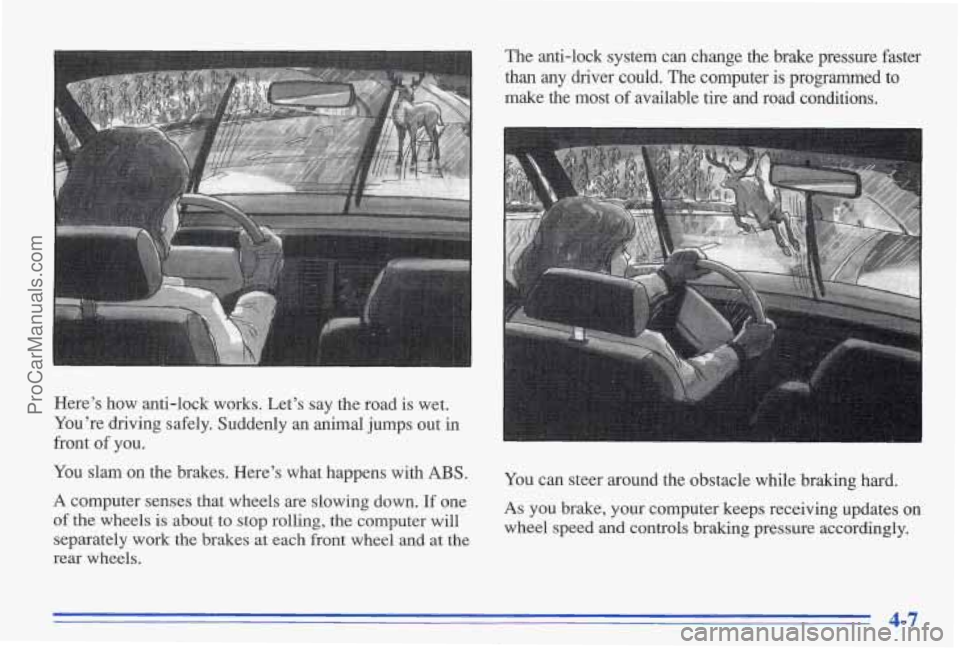
Here’s how anti-lock works. Let’s say the road is wet.
You’re driving safely. Suddenly
an animal jumps out in
front
of you.
You slam on the brakes. Here’s what happens with
ABS.
A computer senses that wheels are slowing down. If one
of the wheels is about to stop rolling, the computer will
separately work the brakes
at each front wheel and at the
rear wheels. The anti-lock system can change the brake pressure faster
than
any driver could. The computer is programmed to
make the most of available tire and road conditions.
You can steer around the obstacle while braking hard.
As you brake, your computer keeps receiving updates on
wheel speed and controls braking pressure accordingly.
ProCarManuals.com
Page 181 of 387
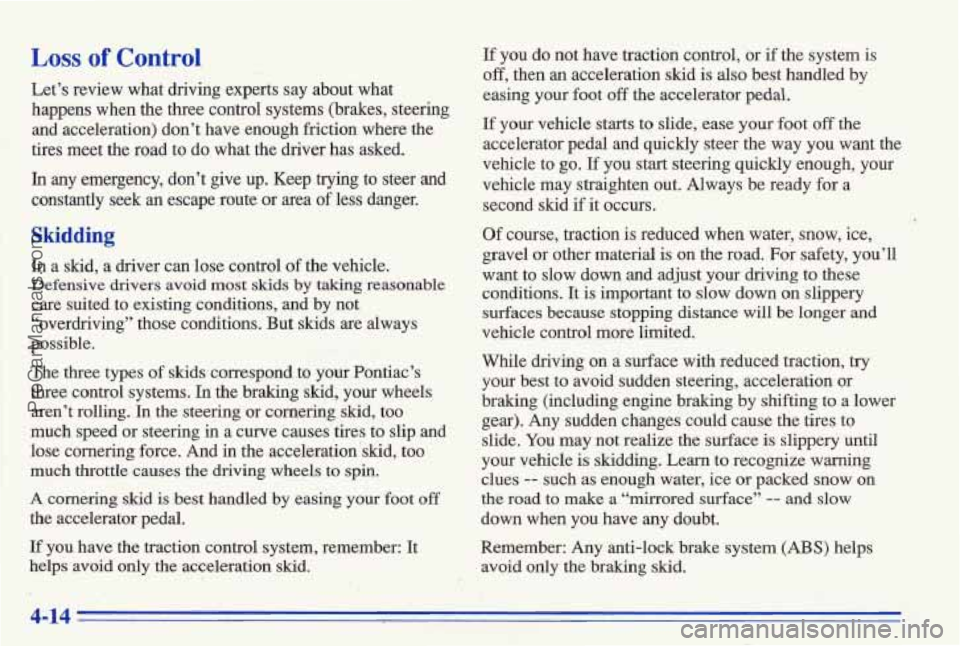
Loss of Control
Let’s review what driving experts say about what
happens when the three control systems (brakes, steering and acceleration) don’t have enough friction where the
tires
meet the road to do what the driver has asked.
In any emergency, don’t give up. Keep trying to steer and
constantly seek
an escape route or area of less danger.
Skidding
In a skid, a driver can lose control of the vehicle.
Defensive drivers avoid most skids by taking reasonable
care suited to existing conditions, and by not
“overdriving” those conditions. But skids
are always
possible.
The three types of skids correspond to your Pontiac’s
three control systems. In the braking skid, your wh’eels
aren’t rolling.
In the steering or cornering skid, too
much speed or steering in a curve causes tires to slip and lose cornering force. And
in the acceleration ‘skid, too
much throttIe causes the driving wheels
to spin.
A cornering skid is best handled by easing your foot off
the accelerator pedal.
If you have the traction control system, remember: It
helps avoid
only the acceleration skid.
If you do not have traction control, or if the system is
off, then an acceleration skid is also best handled by
easing your foot off the accelerator pedal.
If your vehicle starts to slide, ease your foot off the
accelerator pedal and quickly steer the way you want the
vehicle to
go. If you start steering quickly enough, your
vehicle may straighten out. Always be ready for a second skid if it occurs.
Of course, traction
i,s reduced when water, snow, ice,
gravel or other material
is on the road. For safety, you’ll
want to slow down and adjust your driving to these
conditions.
It is important to slow down on slippery
surfaces because stopping distance will
be longer and
vehicle control more limited.
While driving on a surface with reduced traction, try
your best to avoid sudden steering, acceleration or
braking (including engine braking by shifting to a lower
gear). Any sudden changes could cause the tires to
slide. You may not realize the surface
is slippery until
your vehicle is skidding. Learn to recognize warning
clues
-- such as enough water, ice or packed snow on
the road to make a “mirrored surface” -- and slow
down when you have any doubt.
Remember: Any anti-lock brake system
(ABS) helps
avoid only
the braking skid.
4-14
ProCarManuals.com
Page 205 of 387
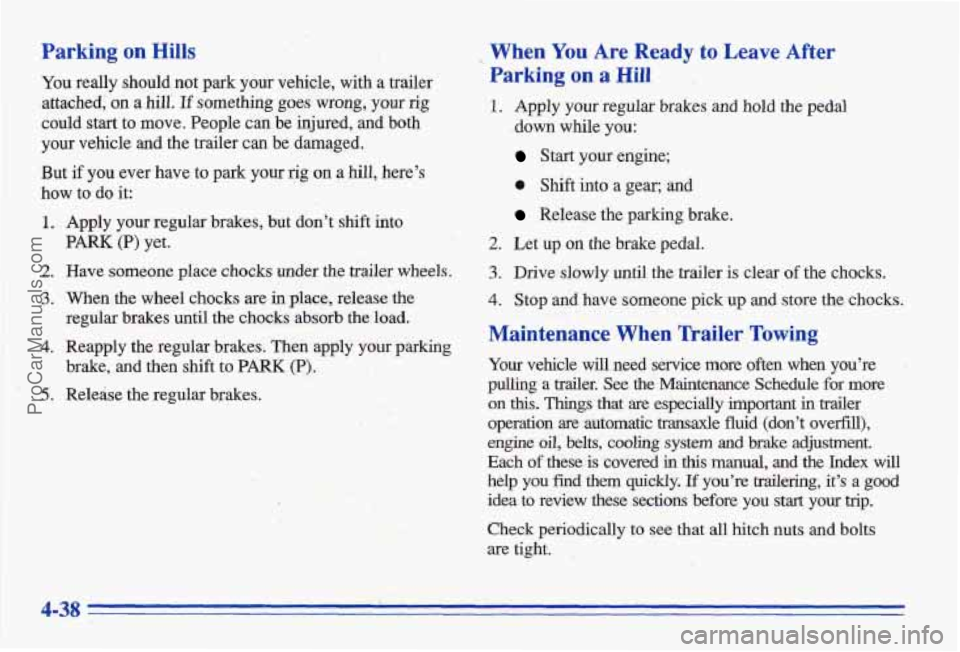
Parking on Hills
You really should not park your vehicle, with a trailer
attached,
on a hill. If something goes wrong, your rig
could start to move. People can be injured, and both
your vehicle and the trailer can be damaged.
But
if you ever have to park your rig on a hill, here’s
how to do it:
1. Apply your regular brakes, but don’t shift into
2. Have someone place chocks under the trailer wheels.
3. When the wheel chocks are in place, release the
regular brakes
mil the chocks absorb the load.
4. Reapply the regular brakes. Then apply your pa;rking
brake, and then shift to PdRK (P).
PARK (P) yet.
’ 5. Release the regular brakes.
~ When You Are Ready to Leave After
Parking on a Hill
1. Apply your regular brakes and hold the pedal
.down while
you:
Start your engine;
e Shift into a gear; and
Release the parking brake.
2. Let up on the brake pedal.
3. Drive slowly until the trailer is clear of the chocks.
4. Stop and have someone pick up and store the chocks.
Maintenance When Trailer Towing
Your vehicle will & service more often when you’re
pmg a trde~ See the Mainte~nance Schedule for more
on this. Things that are especially important in trailer
operation are .automatic
trande fluid (don’t overfill),
engine
oil, belts, cooling system and brake adjustment.
Each
of these is-covered in this manual, and the Index will
help you kd them quickly. If you’re tradering, it’s a good
idea to review these sections before you start your trip.
Check periodically to see that all hitch nuts and bolts
are tight.
4-38
ProCarManuals.com